brake fluid SKODA RAPID 2012 1.G Owner's Manual
[x] Cancel search | Manufacturer: SKODA, Model Year: 2012, Model line: RAPID, Model: SKODA RAPID 2012 1.GPages: 180, PDF Size: 4.36 MB
Page 19 of 180
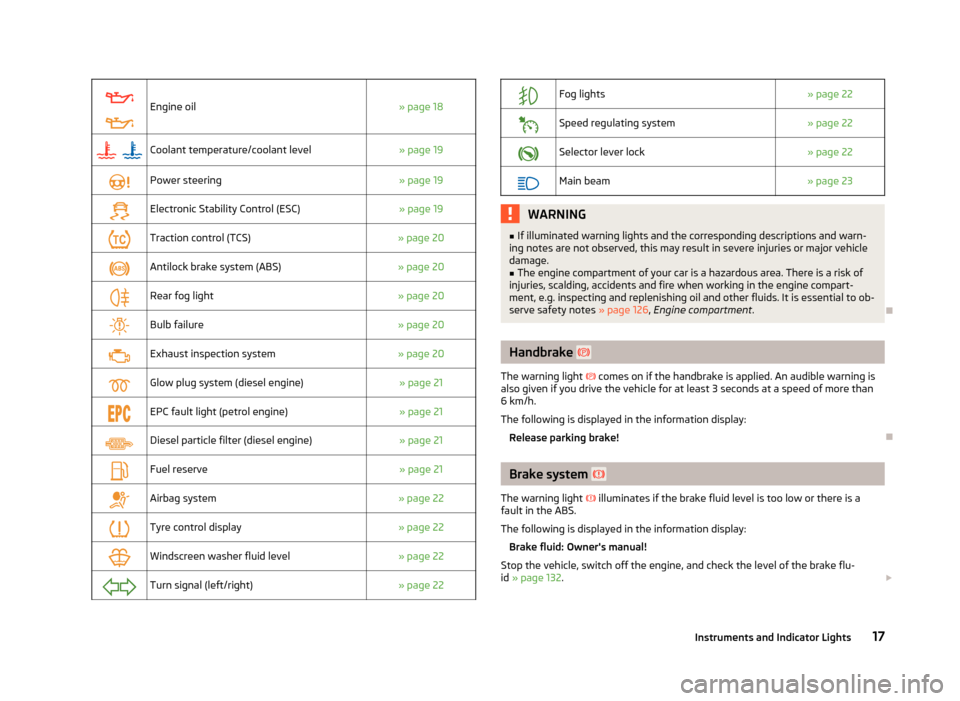
Engine oil
» page 18
Coolant temperature/coolant level
» page 19
Power steering
» page 19
Electronic Stability Control (ESC)
» page 19
Traction control (TCS)
» page 20
Antilock brake system (ABS)
» page 20
Rear fog light
» page 20
Bulb failure
» page 20
Exhaust inspection system
» page 20
Glow plug system (diesel engine)
» page 21
EPC fault light (petrol engine)
» page 21
Diesel particle filter (diesel engine)
» page 21
Fuel reserve
» page 21
Airbag system
» page 22
Tyre control display
» page 22
Windscreen washer fluid level
» page 22
Turn signal (left/right)
» page 22
Fog lights
» page 22
Speed regulating system
» page 22
Selector lever lock
» page 22
Main beam
» page 23 WARNING
■ If illuminated warning lights and the corresponding descriptions and warn-
ing notes are not observed, this may result in severe injuries or major vehicle
damage.
■ The engine compartment of your car is a hazardous area. There is a risk of
injuries, scalding, accidents and fire when working in the engine compart-
ment, e.g. inspecting and replenishing oil and other fluids. It is essential to ob-
serve safety notes »
page 126, Engine compartment . Ð Handbrake
The warning light comes on if the handbrake is applied. An audible warning is
also given if you drive the vehicle for at least 3
seconds at a speed of more than
6 km/h.
The following is displayed in the information display:
Release parking brake! Ð Brake system
The warning light illuminates if the brake fluid level is too low or there is a
fault in the ABS.
The following is displayed in the information display:
Brake fluid: Owner's manual!
Stop the vehicle, switch off the engine, and check the level of the brake flu-
id » page 132. £
17
Instruments and Indicator Lights
Page 20 of 180
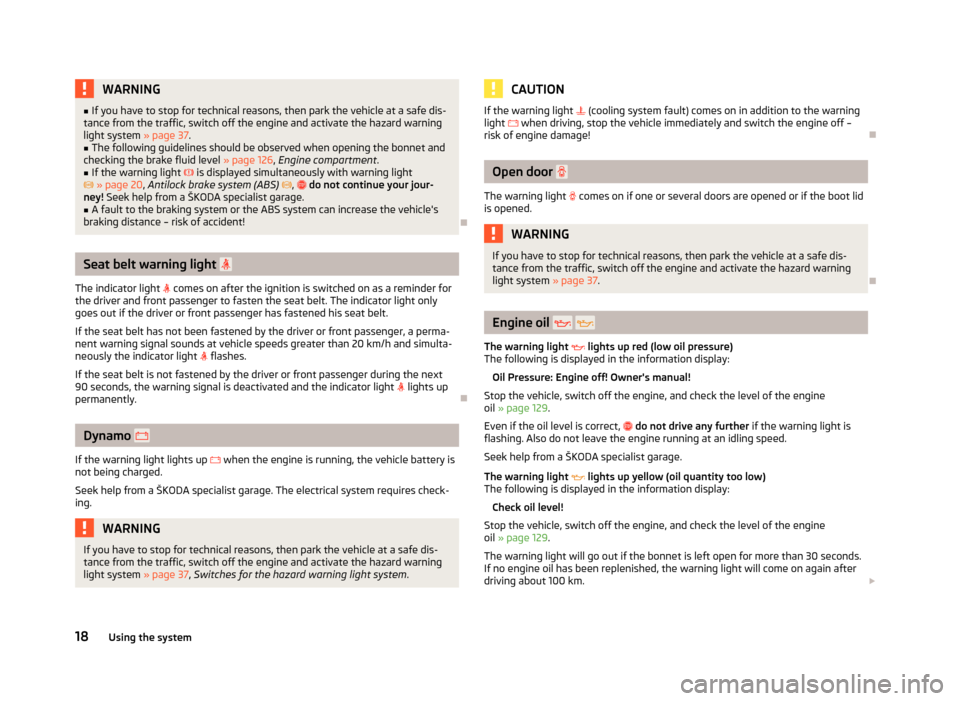
WARNING
■ If you have to stop for technical reasons, then park the vehicle at a safe dis-
tance from the traffic, switch off the engine and activate the hazard warning
light system » page 37.
■ The following guidelines should be observed when opening the bonnet and
checking the brake fluid level »
page 126, Engine compartment .
■ If the warning light is displayed simultaneously with warning light
» page 20, Antilock brake system (ABS) , do not continue your jour-
ney! Seek help from a ŠKODA specialist garage. ■ A fault to the braking system or the ABS system can increase the vehicle's
braking distance – risk of accident! ÐSeat belt warning light
The indicator light comes on after the ignition is switched on as a reminder for
the driver and front passenger to fasten the seat belt. The indicator light only
goes out if the driver or front passenger has fastened his seat belt.
If the seat belt has not been fastened by the driver or front passenger, a perma-
nent warning signal sounds at vehicle speeds greater than 20
km/h and simulta-
neously the indicator light flashes.
If the seat belt is not fastened by the driver or front passenger during the next
90 seconds, the warning signal is deactivated and the indicator light lights up
permanently. ÐDynamo
If the warning light lights up when the engine is running, the vehicle battery is
not being charged.
Seek help from a ŠKODA
specialist garage. The electrical system requires check-
ing. WARNING
If you have to stop for technical reasons, then park the vehicle at a safe dis-
tance from the traffic, switch off the engine and activate the hazard warning
light system » page 37, Switches for the hazard warning light system . CAUTION
If the warning light (cooling system fault) comes on in addition to the warning
light when driving, stop the vehicle immediately and switch the engine off –
risk of engine damage! Ð Open door
The warning light comes on if one or several doors are opened or if the boot lid
is opened. WARNING
If you have to stop for technical reasons, then park the vehicle at a safe dis-
tance from the traffic, switch off the engine and activate the hazard warning
light system » page 37. Ð Engine oil
The warning light lights up red (low oil pressure)
The following is displayed in the information display:
Oil Pressure: Engine off! Owner's manual!
Stop the vehicle, switch off the engine, and check the level of the engine
oil » page 129.
Even if the oil level is correct, do not drive any further if the warning light is
flashing. Also do not leave the engine running at an idling speed.
Seek help from a
ŠKODA specialist garage.
The warning light lights up yellow (oil quantity too low)
The following is displayed in the information display:
Check oil level!
Stop the vehicle, switch off the engine, and check the level of the engine
oil » page 129.
The warning light will go out if the bonnet is left open for more than 30 seconds.
If no engine oil has been replenished, the warning light will come on again after
driving about 100 km. £
18 Using the system
Page 24 of 180
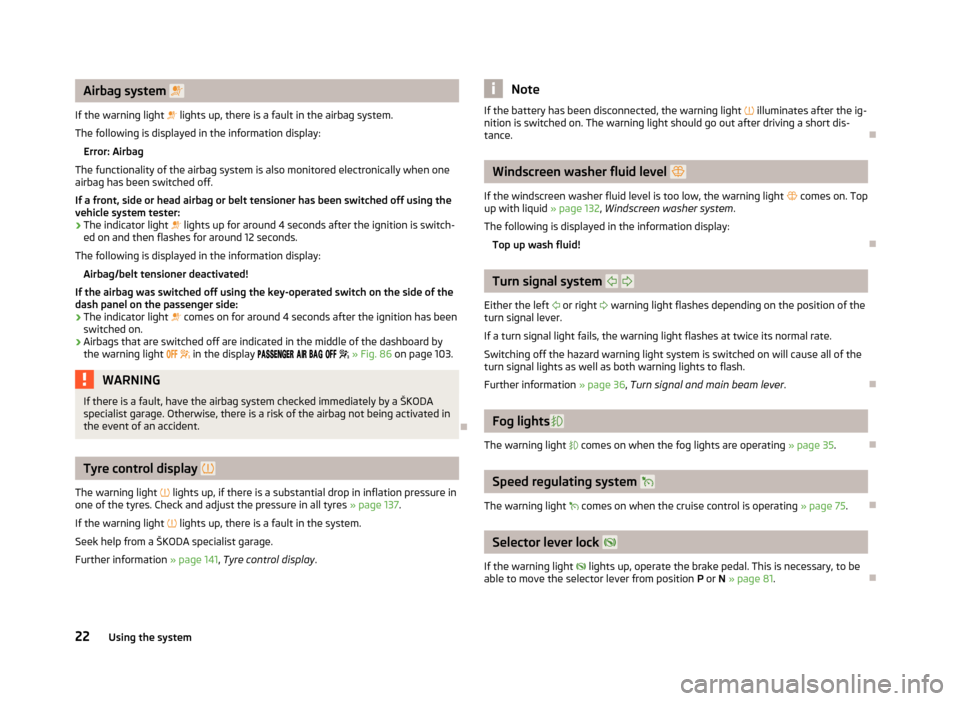
Airbag system
If the warning light lights up, there is a fault in the airbag system.
The following is displayed in the information display: Error: Airbag
The functionality of the airbag system is also monitored electronically when one
airbag has been switched off.
If a front, side or head airbag or belt tensioner has been switched off using the
vehicle system tester:
› The indicator light
lights up for around
4 seconds after the ignition is switch-
ed on and then flashes for around 12 seconds.
The following is displayed in the information display: Airbag/belt tensioner deactivated!
If the airbag was switched off using the key-operated switch on the side of the
dash panel on the passenger side:
› The indicator light
comes on for around 4 seconds after the ignition has been
switched on.
› Airbags that are switched off are indicated in the middle of the dashboard by
the warning light
in the display » Fig. 86 on page 103. WARNING
If there is a fault, have the airbag system checked immediately by a ŠKODA
specialist garage. Otherwise, there is a risk of the airbag not being activated in
the event of an accident. ÐTyre control display
The warning light lights up, if there is a substantial drop in inflation pressure in
one of the tyres. Check and adjust the pressure in all tyres » page 137.
If the warning light lights up, there is a fault in the system.
Seek help from a ŠKODA specialist garage.
Further information »
page 141, Tyre control display . Note
If the battery has been disconnected, the warning light illuminates after the ig-
nition is switched on. The warning light should go out after driving a short dis-
tance. Ð Windscreen washer fluid level
If the windscreen washer fluid level is too low, the warning light comes on. Top
up with liquid » page 132, Windscreen washer system.
The following is displayed in the information display: Top up wash fluid! Ð Turn signal system
Either the left or right warning light flashes depending on the position of the
turn signal lever.
If a turn signal light fails, the warning light flashes at twice its normal rate.
Switching off the hazard warning light system is switched on will cause all of the
turn signal lights as well as both warning lights to flash.
Further information » page 36, Turn signal and main beam lever .Ð Fog lights
The warning light comes on when the fog lights are operating » page 35.Ð Speed regulating system
The warning light comes on when the cruise control is operating » page 75.Ð Selector lever lock
If the warning light lights up, operate the brake pedal. This is necessary, to be
able to move the selector lever from position P or N » page 81. Ð
22 Using the system
Page 74 of 180
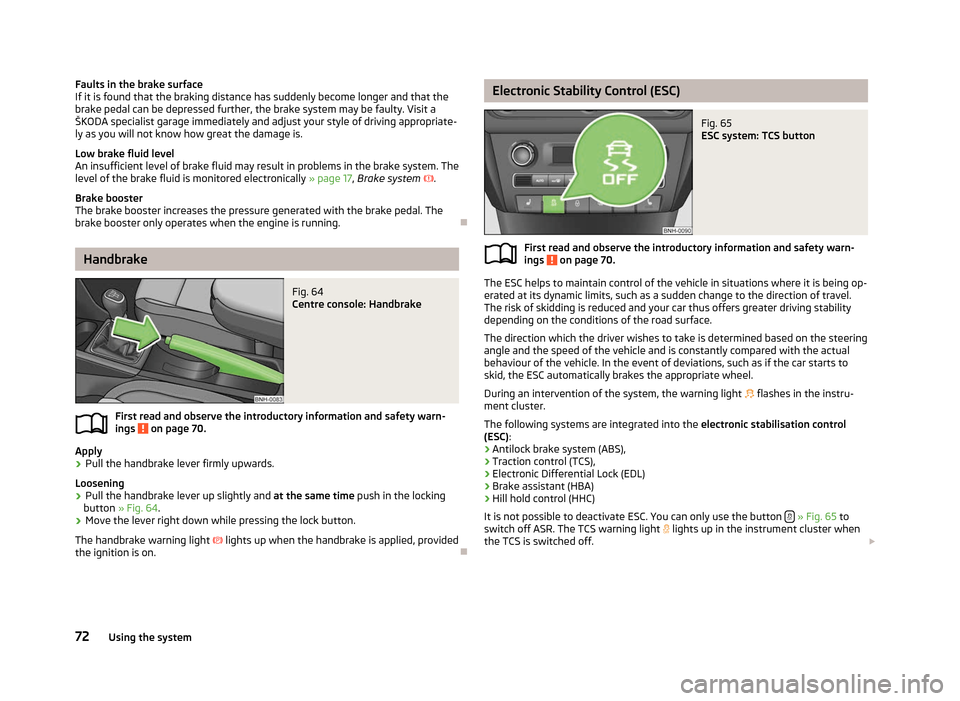
Faults in the brake surface
If it is found that the braking distance has suddenly become longer and that the
brake pedal can be depressed further, the brake system may be faulty. Visit a
ŠKODA specialist garage immediately and adjust your style of driving appropriate-
ly as you will not know how great the damage is.
Low brake fluid level
An insufficient level of brake fluid may result in problems in the brake system. The
level of the brake fluid is monitored electronically
» page 17, Brake system .
Brake booster
The brake booster increases the pressure generated with the brake pedal. The
brake booster only operates when the engine is running. ÐHandbrake
Fig. 64
Centre console: Handbrake
First read and observe the introductory information and safety warn-
ings on page 70.
Apply
› Pull the handbrake lever firmly upwards.
Loosening
› Pull the handbrake lever up slightly and
at the same time push in the locking
button » Fig. 64 .
› Move the lever right down while pressing the lock button.
The handbrake warning light lights up when the handbrake is applied, provided
the ignition is on. Ð
ä Electronic Stability Control (ESC)
Fig. 65
ESC system: TCS button
First read and observe the introductory information and safety warn-
ings on page 70.
The ESC helps to maintain control of the vehicle in situations where it is being op-
erated at its dynamic limits, such as a sudden change to the direction of travel.
The risk of skidding is reduced and your car thus offers greater driving stability
depending on the conditions of the road surface.
The direction which the driver wishes to take is determined based on the steering
angle and the speed of the vehicle and is constantly compared with the actual
behaviour of the vehicle. In the event of deviations, such as if the car starts to
skid, the ESC automatically brakes the appropriate wheel.
During an intervention of the system, the warning light flashes in the instru-
ment cluster.
The following systems are integrated into the electronic stabilisation control
(ESC):
› Antilock brake system (ABS),
› Traction control (TCS),
› Electronic Differential Lock (EDL)
› Brake assistant (HBA)
› Hill hold control (HHC)
It is not possible to deactivate ESC. You can only use the button » Fig. 65
to
switch off ASR. The TCS warning light lights up in the instrument cluster when
the TCS is switched off. £
ä
72 Using the system
Page 128 of 180

Diesel fuel
First read and observe the introductory information and safety warn-
ings on page 124.
Your vehicle can only be operated with
diesel fuel, which complies with the
standard EN
590 (standard DIN 51628 in Germany, standard ÖNORM C 1590 in
Austria, GOST R 52368-2005/EN 590:2004 in Russia).
Operation in winter – Winter-grade diesel fuel
In the winter, only use diesel fuel, which complies with the standard EN 590
(standard DIN 51628 in Germany, standard ÖNORM C 1590 in Austria,
GOST R 52368-2005/EN 590:2004 in Russia). “Winter-grade diesel fuel” will still
operate properly even at a temperature of -20 °C.
It is often the case in countries with different climatic conditions that diesel fuels
available have a different temperature characteristic. The ŠKODA Service Partners
and filling stations in the relevant country will be able to provide you with infor-
mation regarding the diesel fuels available.
Preheating fuel
The vehicle is fitted with a fuel filter preheating system. This secures operation of
a vehicle using diesel fuel down to an environmental temperature of -25 °C.
Fuel additives
Fuel additives, so-called “flow improvers” (petrol and similar products) must not
be added to the diesel fuel. CAUTION
■ Just filling the tank once with diesel fuel that does not comply with the stand-
ard, can cause severe damage to parts of the engine, the fuel and exhaust sys-
tem!
■ If a different fuel other than diesel fuel, which complies to the above mentioned
standards (e.g. petrol) is used by mistake do not start the engine or switch on the
ignition! Extensive damage to engine parts can occur! We recommend that the
fuel system is cleaned by a
ŠKODA Service Partner.
■ Water which has collected in the fuel filter can cause engine faults.
■ Your vehicle is not adapted for use of biofuel (RME), therefore this fuel must not
be refuelled and driven. The use of biofuel (RME) can cause considerable damage
to parts of the engine or fuel system. Ð
ä Engine compartment
ä
Introduction
This chapter contains information on the following subjects:
Opening and closing the bonnet 128
Engine compartment overview 128
Checking the engine oil level 129
Replenishing the engine oil 129
Changing engine oil 130
Coolant 130
Checking the coolant level 130
Replenishing the coolant 131
Radiator fan 131
Checking the brake fluid 132
Brake fluid change 132
Windscreen washer system 132
There is a risk of injuries, scalding, accidents and fire when working in the en-
gine compartment, e.g. inspecting and replenishing oil and other fluids. For this
reason, it is essential to comply with the warning instructions stated below and
with the general applicable rules of safety. The vehicle's engine compartment is
a hazardous area . WARNING
■ Never open the bonnet if you can see steam or coolant flowing out of the
engine compartment – risk of scalding! Wait until the steam or coolant has
stopped escaping.
■ Turn off the engine and withdraw the ignition key.
■ If the vehicle is fitted with a manual gearbox, move the gearshift lever into
Neutral, or if the vehicle is fitted with an automatic gearbox, move the selec-
tor lever into position P .
■ Firmly apply the handbrake.
■ Allow the engine to cool.
■ For safety reasons, the bonnet must always be properly closed when driving.
This is why after closing the bonnet, the lock must always be checked to en-
sure it has engaged properly. £
126 General Maintenance
Page 130 of 180

Opening and closing the bonnet
Fig. 96
Bonnet/radiator grille release lever: Release lever Fig. 97
Securing the bonnet
First read and observe the introductory information and safety warn-
ings on page 126.
Opening
›
Open the front left door.
› Pull the release lever under the dash panel 1
» Fig. 96
in the direction of the
arrow.
Before opening the bonnet, ensure that the arms of the windscreen wipers are
correctly in place against the windscreen otherwise the paintwork could be dam-
aged.
› Press the release lever in the direction of the arrow 2
» Fig. 96
and the bonnet
is unlocked.
› Grab hold of the bonnet and lift.
ä ›
Take the bonnet support out of its holder 3
in the direction of the ar-
row » Fig. 97 and secure the opened bonnet by inserting the end of the support
in the opening 4
in the bonnet.
Closing
› Lift the bonnet slightly and unhook the bonnet support. Press the bonnet sup-
port into the holder 3
designed to hold it.
› Let the bonnet drop into the lock carrier lock from a height of around 20 cm –
do not push it in .
› Check that the bonnet is closed properly. Ð Engine compartment overview
Fig. 98
1.2 ltr./63 kW TSI petrol engine
First read and observe the introductory information and safety warn-
ings on page 126.
Coolant expansion reservoir 130
Windscreen washer fluid reservoir 132
Engine oil filler opening 129
Engine oil dipstick 129
Brake fluid reservoir 132
Vehicle battery 133
£
ä 1
2
3
4
5
6
128
General Maintenance
Page 134 of 180

Checking the brake fluid
Fig. 101
Engine compartment: Brake fluid
reservoir
First read and observe the introductory information and safety warn-
ings on page 126.
The brake fluid reservoir is located in the engine compartment.
›
Switch off the engine.
› Open the bonnet
» page 128.
› Check the level of brake fluid in the reservoir
» Fig. 101. The level must be be-
tween the “MIN” and “MAX” markings.
When driving, a slight drop in the fluid level is caused by the wear-and-tear and
automatic adjustment of the brake pads, and is therefore perfectly normal.
There may be an indication of a leak in the brake system, however, if the fluid lev-
el drops significantly within a short time or if it drops below the “MIN” marking. If
the brake fluid level is too low, this is indicated by the warning light lighting up
in the instrument cluster » page 17, Brake system . WARNING
If the fluid level has dropped below the MIN marking, do not continue your
journey – risk of accident! Seek help from a
ŠKODA specialist garage.ÐBrake fluid change
First read and observe the introductory information and safety warn-
ings on page 126.ä
ä Brake fluid absorbs moisture. Over time it therefore absorbs moisture from the
environment. Excessive water in the brake fluid may be the cause of corrosion in
the brake system. The water content also lowers the boiling point of the brake
fluid.
The brake fluid must comply with the following standards or specifications:
› VW 50114;
› FMVSS 116 DOT4. WARNING
Using old brake fluid can result in severe stress on the brakes because of the
formation of vapour bubbles in the brake system. This greatly impairs the
braking efficiency and thus also the safety of your vehicle. CAUTION
Brake fluid damages the paintwork of the vehicle. Ð Windscreen washer system
Fig. 102
Engine compartment: Wind-
screen washer fluid reservoir
First read and observe the introductory information and safety warn-
ings on page 126.
The windscreen washer fluid reservoir contains the cleaning fluid for the wind-
screen or rear window and for the headlight cleaning system. The windscreen
washer fluid reservoir is located in the engine compartment.
The capacity of the reservoir is about 3.5 litres or about 5.4
litres on vehicles that
have a headlight cleaning system. £
ä
132 General Maintenance
Page 172 of 180

Index
A
ABS 73
Warning light 20
Accessories 144
Adjusting Exterior mirror 42
Adjusting seats 92
Adjustment Seat 45
Aerial 118
see Radio reception 120
Airbag 99
Deployment 99
Front airbag 100
Head airbag 102
Side airbag 101
Airbag system 99
Air conditioning system Air outlet vents 60
Climatronic 65
Manual air conditioning system 62
Alarm 29
Anti-theft alarm system 29
Antilock brake system 73
Armrest 45
rear 48
Ashtray 53
ASR 73
Assist systems ABS 20, 73
ASR 73
Cruise control systems (CCS) 75
EDL 73
ESC 19, 72
Parking aid 74START/STOP 77
TCS 20
Auto Check Control 16
Automatic gearbox 79
Dynamic shift programme 82
Emergency programme 82
Information for driving 79
Kickdown 82
Manual shifting of gears 81
Parking 80
Selector lever-emergency unlocking 83
Selector lever lock 81
Selector lever positions 80
Starting off 80
Stopping 80
Tiptronic 81
Automatic load deactivation 136
AUX-IN 90
Avoiding damage to your vehicle 113
B
Before setting off 91
Belts 95
Belt tensioners 98
Bonnet Closing 128
Opening 128
Boot Class
N1 vehicles 49
Cover 50
Emergency unlocking 31
Fastening elements 49
Fixing nets 50
Hooks 50
Light 49
see Boot lid 31
Unlocking the boot lid 31
Boot lid 31
Automatic locking 31
Brake assist 72Brake booster 72
Brake fluid Checking 132
Brakes Brake booster 72
Handbrake 72
Running in 109
Warning light 17
Braking Brake fluid 132
Breakdown kit 149
Bulbs Replacing 159
Button in the driver's door Electrical power windows 31
C
Car computer see Multifunction display 11
Car jack 145
Carrier 51
Catalytic converter 109
Central locking button 27
Central locking system 25
lock 27
unlock 26
Changes 144
Changing Engine oil 130
Wheel 146
Charging a vehicle battery 135
Checking Battery electrolyte level 135
Brake fluid 132
Coolant level 130
Engine oil 129
Oil level 129
Windscreen washer fluid 132
Children and safety 105
170 Index
Page 173 of 180
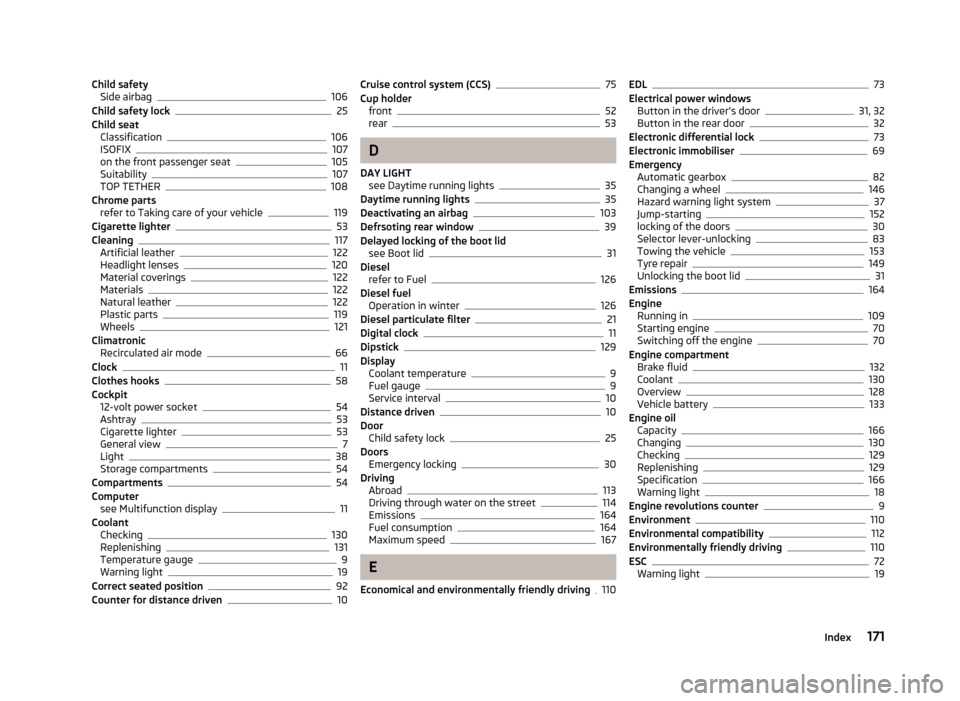
Child safety
Side airbag 106
Child safety lock 25
Child seat Classification 106
ISOFIX 107
on the front passenger seat 105
Suitability 107
TOP TETHER 108
Chrome parts refer to Taking care of your vehicle 119
Cigarette lighter 53
Cleaning 117
Artificial leather 122
Headlight lenses 120
Material coverings 122
Materials 122
Natural leather 122
Plastic parts 119
Wheels 121
Climatronic Recirculated air mode 66
Clock 11
Clothes hooks 58
Cockpit 12-volt power socket 54
Ashtray 53
Cigarette lighter 53
General view 7
Light 38
Storage compartments 54
Compartments 54
Computer see Multifunction display 11
Coolant Checking 130
Replenishing 131
Temperature gauge 9
Warning light 19
Correct seated position 92
Counter for distance driven 10Cruise control system (CCS) 75
Cup holder front 52
rear 53
D
DAY LIGHT see Daytime running lights 35
Daytime running lights 35
Deactivating an airbag 103
Defrsoting rear window 39
Delayed locking of the boot lid see Boot lid 31
Diesel refer to Fuel 126
Diesel fuel Operation in winter 126
Diesel particulate filter 21
Digital clock 11
Dipstick 129
Display Coolant temperature 9
Fuel gauge 9
Service interval 10
Distance driven 10
Door Child safety lock 25
Doors Emergency locking 30
Driving Abroad 113
Driving through water on the street 114
Emissions 164
Fuel consumption 164
Maximum speed 167
E
Economical and environmentally friendly driving 110EDL 73
Electrical power windows Button in the driver's door 31, 32
Button in the rear door 32
Electronic differential lock 73
Electronic immobiliser 69
Emergency Automatic gearbox 82
Changing a wheel 146
Hazard warning light system 37
Jump-starting 152
locking of the doors 30
Selector lever-unlocking 83
Towing the vehicle 153
Tyre repair 149
Unlocking the boot lid 31
Emissions 164
Engine Running in 109
Starting engine 70
Switching off the engine 70
Engine compartment Brake fluid 132
Coolant 130
Overview 128
Vehicle battery 133
Engine oil Capacity 166
Changing 130
Checking 129
Replenishing 129
Specification 166
Warning light 18
Engine revolutions counter 9
Environment 110
Environmental compatibility 112
Environmentally friendly driving 110
ESC 72
Warning light 19
171
Index
Page 175 of 180

O
Oil refer to Engine oil 129
Onboard computer see Multifunction display 11
Operation in winter De-icing windows 120
Diesel fuel 126
Vehicle battery 135
Outside temperature 13
Overview Engine compartment 128
Warning lights 16
P
Paint see Paint damage 119
Paint damage 119
Parking Parking aid 74
Parking ticket holder 58
Passive Safety 91
Periodic wiping 40
Petrol refer to Fuel 125
Polishing the paintwork refer to Taking care of your vehicle 119
Power steering 69
Preservation refer to Taking care of your vehicle 119
R
Radiator fan 131
Radio reception Aerial 120
Functional fault 120
Raise vehicle 148Rear mirror
Exterior mirror 42
Manual dimming interior mirror 42
Recirculated air mode Manual air conditioning system 64
Recommended gear 11
Refuelling 124
Fuel 124
Regulation Headlamp range 36
Remote control 27
Synchronisation process 28
Remote control key Replacing the battery 24
Replacement of parts 144
Replacing bulbs 159
Fuses 156
Vehicle battery 136
Wiper blades 41, 42
Replenishing Coolant 131
Engine oil 129
Windscreen washer fluid 132
Roof luggage rack Attachment points 52
Roof rack system Roof load 52
Running in Brake pads 109
Engine 109
The first 1 500 km 109
Tyres 109
S
Safe securing system 26
Safety 91
Child safety 105
Child safety seats 105
Head restraints 46ISOFIX 107
TOP TETHER 108
Save electrical energy 110
Seat Adjusting 45
Seat belt Warning light 18
Seat belt height adjuster 98
Seat belts 95
Cleaning 123
fastening and unfastening 97
Height adjustment 98
Seats folding forward 47
Head restraints 46
Heating 46
Selector lever see selector lever positions 80
Selector lever positions 80
Service display 10
Setting Manual air conditioning system 64
Manual dimming interior mirror 42
Steering wheel 69
Setting temperature Heating 60
Setting the clock Clock 11
Shifting Diving economically 110
Gearshift lever 74
Side airbag 101
Snow chains 143
Spare wheel 140
Speedometer 9
START/STOP Function 77
Starting engine 70
Jump-starting 152
173
Index